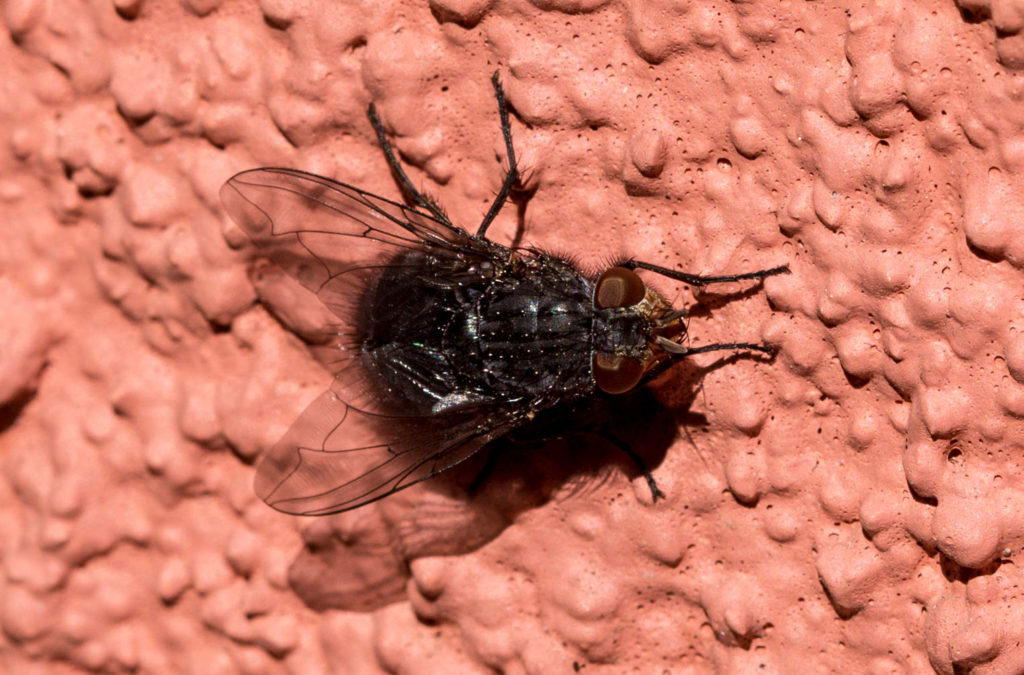
We had a flicker — you know, a kind of woodpecker — in the backyard this morning. And a robin and a bunch of sparrows. And an anise swallowtail butterfly that was hanging out in a little anise bush that’s regenerating itself after being cut to the ground last year.
But above is what I got a picture of: a fly.
A blue bottle fly, perhaps Calliphora vomitoria (Linnaeus 1758), or perhaps Calliphora vicina (Robineau-Desvoidy, 1830).
Both species are part of a group known as blow flies. I won’t dwell on their habits — we all sort of know what flies are up to for a good part of their lives. But like everything else that flies, buzzes, creeps and crawls around us — except maybe mosquitoes — these flies fit in somewhere. Here’s what the Encyclopedia of Life (with its British spellings) has to say about C. vicina under the category “benefits”:
Unless there is something to prevent their access, blowflies will rapidly colonise a human corpse. For this reason, they are frequently encountered by police who are investigating suspicious deaths. It is now recognised that an exploration of the insect community on a corpse can contribute valuable information to the forensic investigation and the field of forensic entomology is relatively well established. Due to their ability to locate corpses so quickly after death, blowflies have proved more useful than any other insects in giving an estimate of the minimum post-mortem interval (the time elapsed since death). To do this the forensic entomologist models the growth of the blowfly larvae recovered from the remains in relation to the scene temperatures. To date, the forensic entomology team at the Natural History Museum have been involved in some 120 forensic cases. Calliphora vicina was the primary blowfly species recovered in most of these.
And here are benefits attributed to C. vomitoria, which could prove valuable at a time when we seem to be killing pollinators:
Although blue bottle fly larvae eat carrion, the adult flies frequently feed on flowers with exposed nectaries. Pollen grains become attached to the flies’ body hair and are moved from flower to flower as they search for nectar, a process known as incidental pollination. Typically the blue bottle fly visits flowers with a strong odor often resembling rotting meat. Plants pollinated by the fly include the American pawpaw (Asimina triloba), dead horse arum (Helicodiceros muscivorus), skunk cabbage (Symplocarpus foetidus), goldenrod (Solidago spp.), and members of the carrot family like Queen Anne’s lace (Daucus carota).
At the North Central Regional Plant Introduction Station (NCRPIS) in Ames, Iowa, both the blue bottle fly and the common house fly (Musca domestica) are used to pollinate plants of the carrot family in the field and greenhouses. Several farms have used blue bottle flies to successfully pollinate vegetable crops including carrots, broccoli, lettuce, and canola. As managed pollinators, the blue bottle fly is non-aggressive to humans; the pupae are cheap to purchase and can be stored for three weeks; and the flies work in smaller areas and at cooler temperatures than bees. For these reasons, the blue bottle fly is actually being used as an alternative to bee pollinators.
I tried and failed to discover what the Latin word “vomitoria” means in the species naming context. I note, though, there appear to be more plant than animal species named vomitoria. Ilex vomitoria, for instance.
